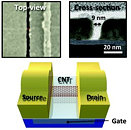Monday, January 30th 2012

IBM Creates 9 nm Transistors Using Carbon Nanotubules
Researchers at IBM have developed the smallest carbon nanotubule transistor, that is 9 nanometers (nm) across. In comparison, the smallest transistors possible using silicon is 10 nm across. IBM claims its new transistor consumes less power while being able to carry more current than today's technology.
"The results really highlight the value of nanotubes in the most sophisticated type of transistors," says John Rogers, professor of materials science at the University of Illinois at Urbana-Champaign. "They suggest, very clearly, that nanotubes have the potential for doing something truly competitive with, or complementary to, silicon." Currently, the smallest production-grade transistors are 22 nm across.The success of 9 nm carbon nanotubule transistors potentially extends the life of conventional electronics as we know it, as it breaches the 10 nm limit of silicon transistors. "If nanotubes can't go much further than silicon, then working on them is a waste of time," says Aaron Franklin, a researcher at the IBM Watson Research Center in Yorktown Heights, New York. "We've made nanotube transistors at aggressively scaled dimensions, and shown they are tremendously better than the best silicon devices." The research team, however, is faced with development hurdles. Manufacturing large batches of carbon nanotubules that function as semiconductors is difficult.
Sources:
TechnologyReview.in, Engadget
"The results really highlight the value of nanotubes in the most sophisticated type of transistors," says John Rogers, professor of materials science at the University of Illinois at Urbana-Champaign. "They suggest, very clearly, that nanotubes have the potential for doing something truly competitive with, or complementary to, silicon." Currently, the smallest production-grade transistors are 22 nm across.The success of 9 nm carbon nanotubule transistors potentially extends the life of conventional electronics as we know it, as it breaches the 10 nm limit of silicon transistors. "If nanotubes can't go much further than silicon, then working on them is a waste of time," says Aaron Franklin, a researcher at the IBM Watson Research Center in Yorktown Heights, New York. "We've made nanotube transistors at aggressively scaled dimensions, and shown they are tremendously better than the best silicon devices." The research team, however, is faced with development hurdles. Manufacturing large batches of carbon nanotubules that function as semiconductors is difficult.


8 Comments on IBM Creates 9 nm Transistors Using Carbon Nanotubules
* Considering they were using very old equipment it's posible that they could go smaller than what they did, only that's the equipment they used back then.
Okay next step is to use the protein based nano tubes material that doubles as heatsink if used as pcboard material, aluminum replacement, space construction material (that can be produced on demand and scaled during space travel) to build 3D nano tube grids similar to Intel tri-gate just not as primitive.
I guess I have to spoon feed even this to Intel and IBM again :banghead:
O well .....